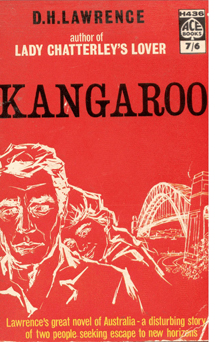
The
1962 Ace edition of Kangaroo
- showing the Sydney Harbour Bridge 10 years before it
was built. This paperback edition was clearly a cheap
effort to cash in on the success of the Lady
Chatterley
court case in London, which had the effect of allowing
Lawrence's best-known work to be legally published.
THROUGHOUT
THE 70s, 80s, 90s and well into the new century, the prime
suspect - the main focus of our research - was Jack Scott.
There was no question in my mind - and in Andrew Moore's,
too - that he was the main source of Lawrence's information
about the secret army. (I think John Ruffels was also
convinced of that, as was of course my wife and co-conspirator,
Sandra. To give him credit, I believe that Joe Davis now
also thinks this.)
Jack Scott was almost certainly the principal Australian
character in Kangaroo. He was the sinister Jack
Callcott - the very personification of "the scaly
back of a reptile, and the horrible paws".
Yet, as intimated above, there is an anomaly, or oddity,
here.
Why didn't Lawrence disguise him more?
Why, in particular, didn't Lawrence, as he progressively
became aware of the full evilness of what Callcott represented,
go back over the manuscript and make it less obvious that
his erstwhile "mate" Jack Scott was the co-leader
of the Diggers-Maggies secret-army organisation (aka the
King and Empire Alliance)?
Why, to use an Australianism, did he "dob him in"?
Indeed, why were there no "backward revisions"
at all in the manuscript - the question that had worried
me back in the 1970s, when I first saw the holograph of
Kangaroo?
Surely Lawrence must have realised the danger he was putting
himself into...especially as he well knew that Scott and
Rosenthal and the rest would one day soon read the exposé
he was writing, literally, behind their backs.
Then the cat - or the scaly reptile with the horrible
paws - would be well and truly out of the bag.
One answer might be put down to Lawrence's notorious insensitivity
to the feelings of people he portrayed in his fiction.
Neville had remarked on this, and throughout his writing
career other examples abound. (How could he, for example,
have put the raddled character Lady Hermione Roddice into
Women in Love knowing how much it would offend
his loyal and supportive patron, Lady Ottoline Morrell?)
It was almost as if there was something in his method
of writing - his authorial technique, as it were - that
inhibited him from "interfering" with or questioning
how he converted fact into fiction, and its "automatic"
functions.
Yet there was another possible explanation that was emerging
from the research.
Maybe, like Victoria Callcott, the character Jack Callcott
was an amalgam of more than one person.
Maybe he was based on Scott plus somebody else.
